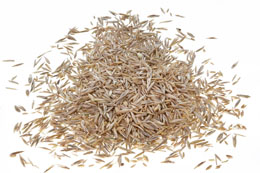Grass plays a significant role in keeping your lawns bright and green. Like other plants, grasses, too, need specific conditions for their survival. Scroll down to know when to plant grass seeds and how.

Grass seeds require proper soil contact, in order to germinate. They must be properly surrounded by soil. Proper germination of the seeds require a correct depth. The soil should be placed ⅛ to ¼ inch above the seed. For proper nutrition, the soil should contain good moisture that can enter the seeds. Watering depends upon the type of the soil, which can be numerous times in a day. Water is highly essential to keep the soil moist. You can try a light roller to keep the soil surrounding the seeds, tight. This helps in the better germination.
When Should Grass Seeds be Planted
The season is one of the most important things to be considered while planting grass seeds. They are usually sown, before or after the summer. This is because, during summer, seeds cannot be kept moist all the time; so watering is constantly needed. One more reason that contributes to this factor is that heating of the soil helps the weed seeds to grow faster. Weed control is necessary for maintaining the greens. Plantation in summer requires peat moss mixture, that is added to the soil to prevent drying out of the seeds.
So, early fall is the best time for sowing. During this time, weather is mild to moderate, and the soil remains warm during daytime. However, one has to make sure that the new grass is able to withstand the winter. Fertilize the seeds with a starter fertilizer, followed by more fertilizers. Frequent watering fades away the first application of fertilizer from the top layer of the soil. Hence, a second treatment is required to nourish the young roots.
Planting Instructions
Purchasing the right seed is very important. This is because any seed that has the ability to tolerate drought, and remain free from any diseases is good for sowing. Follow these steps for planting the seeds.
- Tease apart two to three inches of soil. Clean it by removing stones and other soil particles, and break the larger chunks. Very small soil clumps can be kept, as it will not cause harm to the seeds. Keep the planting area leveled, so that sufficient amount of water gets accumulated. Feed the seeds with a good fertilizer.
- Disperse the seeds uniformly with the help of a lawn spreader for larger areas. You can use your hands for spreading them in smaller areas. You can spread up to sixteen seeds per square area. This is because, sowing the seeds apart from each other creates more space for growth, and ensures availability of the nutrients.
- Wrap up the seed bed with fertilizers. This helps more growth in lesser time. Fertilized soil retains the moisture contents, and results in better growth. Water the seeds, at least once in a day, until it reaches a minimum two inches. After the grasses have come out, water them regularly to keep the soil damp.
The time and method of planting the seeds may depend upon the type of grass you are using. Cool season grass grows better in early spring and early fall; whereas warm season grass grows well in late spring and early summer. Along with these factors, the availability of seeds should also be checked.






 Grass seeds require proper soil contact, in order to germinate. They must be properly surrounded by soil. Proper germination of the seeds require a correct depth. The soil should be placed ⅛ to ¼ inch above the seed. For proper nutrition, the soil should contain good moisture that can enter the seeds. Watering depends upon the type of the soil, which can be numerous times in a day. Water is highly essential to keep the soil moist. You can try a light roller to keep the soil surrounding the seeds, tight. This helps in the better germination.
Grass seeds require proper soil contact, in order to germinate. They must be properly surrounded by soil. Proper germination of the seeds require a correct depth. The soil should be placed ⅛ to ¼ inch above the seed. For proper nutrition, the soil should contain good moisture that can enter the seeds. Watering depends upon the type of the soil, which can be numerous times in a day. Water is highly essential to keep the soil moist. You can try a light roller to keep the soil surrounding the seeds, tight. This helps in the better germination.